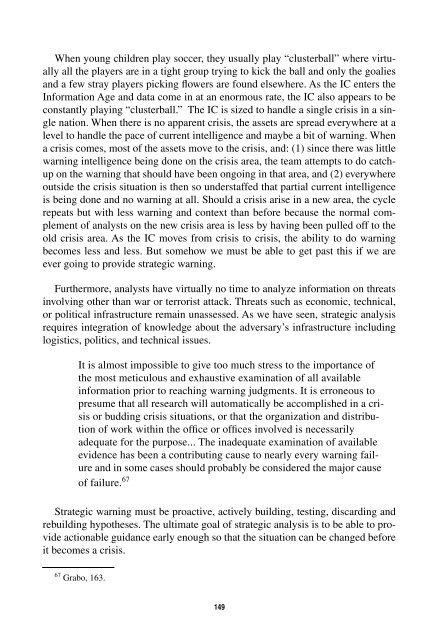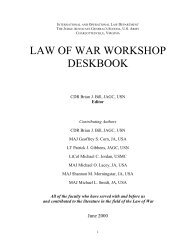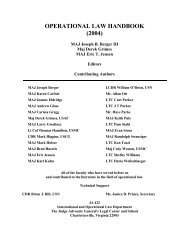Warning Analysis for the Information Age - Higgins Counterterrorism ...
Warning Analysis for the Information Age - Higgins Counterterrorism ...
Warning Analysis for the Information Age - Higgins Counterterrorism ...
You also want an ePaper? Increase the reach of your titles
YUMPU automatically turns print PDFs into web optimized ePapers that Google loves.
When young children play soccer, <strong>the</strong>y usually play “clusterball” where virtuallyall <strong>the</strong> players are in a tight group trying to kick <strong>the</strong> ball and only <strong>the</strong> goaliesand a few stray players picking flowers are found elsewhere. As <strong>the</strong> IC enters <strong>the</strong>In<strong>for</strong>mation <strong>Age</strong> and data come in at an enormous rate, <strong>the</strong> IC also appears to beconstantly playing “clusterball.” The IC is sized to handle a single crisis in a singlenation. When <strong>the</strong>re is no apparent crisis, <strong>the</strong> assets are spread everywhere at alevel to handle <strong>the</strong> pace of current intelligence and maybe a bit of warning. Whena crisis comes, most of <strong>the</strong> assets move to <strong>the</strong> crisis, and: (1) since <strong>the</strong>re was littlewarning intelligence being done on <strong>the</strong> crisis area, <strong>the</strong> team attempts to do catchupon <strong>the</strong> warning that should have been ongoing in that area, and (2) everywhereoutside <strong>the</strong> crisis situation is <strong>the</strong>n so understaffed that partial current intelligenceis being done and no warning at all. Should a crisis arise in a new area, <strong>the</strong> cyclerepeats but with less warning and context than be<strong>for</strong>e because <strong>the</strong> normal complementof analysts on <strong>the</strong> new crisis area is less by having been pulled off to <strong>the</strong>old crisis area. As <strong>the</strong> IC moves from crisis to crisis, <strong>the</strong> ability to do warningbecomes less and less. But somehow we must be able to get past this if we areever going to provide strategic warning.Fur<strong>the</strong>rmore, analysts have virtually no time to analyze in<strong>for</strong>mation on threatsinvolving o<strong>the</strong>r than war or terrorist attack. Threats such as economic, technical,or political infrastructure remain unassessed. As we have seen, strategic analysisrequires integration of knowledge about <strong>the</strong> adversary’s infrastructure includinglogistics, politics, and technical issues.It is almost impossible to give too much stress to <strong>the</strong> importance of<strong>the</strong> most meticulous and exhaustive examination of all availablein<strong>for</strong>mation prior to reaching warning judgments. It is erroneous topresume that all research will automatically be accomplished in a crisisor budding crisis situations, or that <strong>the</strong> organization and distributionof work within <strong>the</strong> office or offices involved is necessarilyadequate <strong>for</strong> <strong>the</strong> purpose... The inadequate examination of availableevidence has been a contributing cause to nearly every warning failureand in some cases should probably be considered <strong>the</strong> major causeof failure. 67Strategic warning must be proactive, actively building, testing, discarding andrebuilding hypo<strong>the</strong>ses. The ultimate goal of strategic analysis is to be able to provideactionable guidance early enough so that <strong>the</strong> situation can be changed be<strong>for</strong>eit becomes a crisis.67 Grabo, 163.149
















